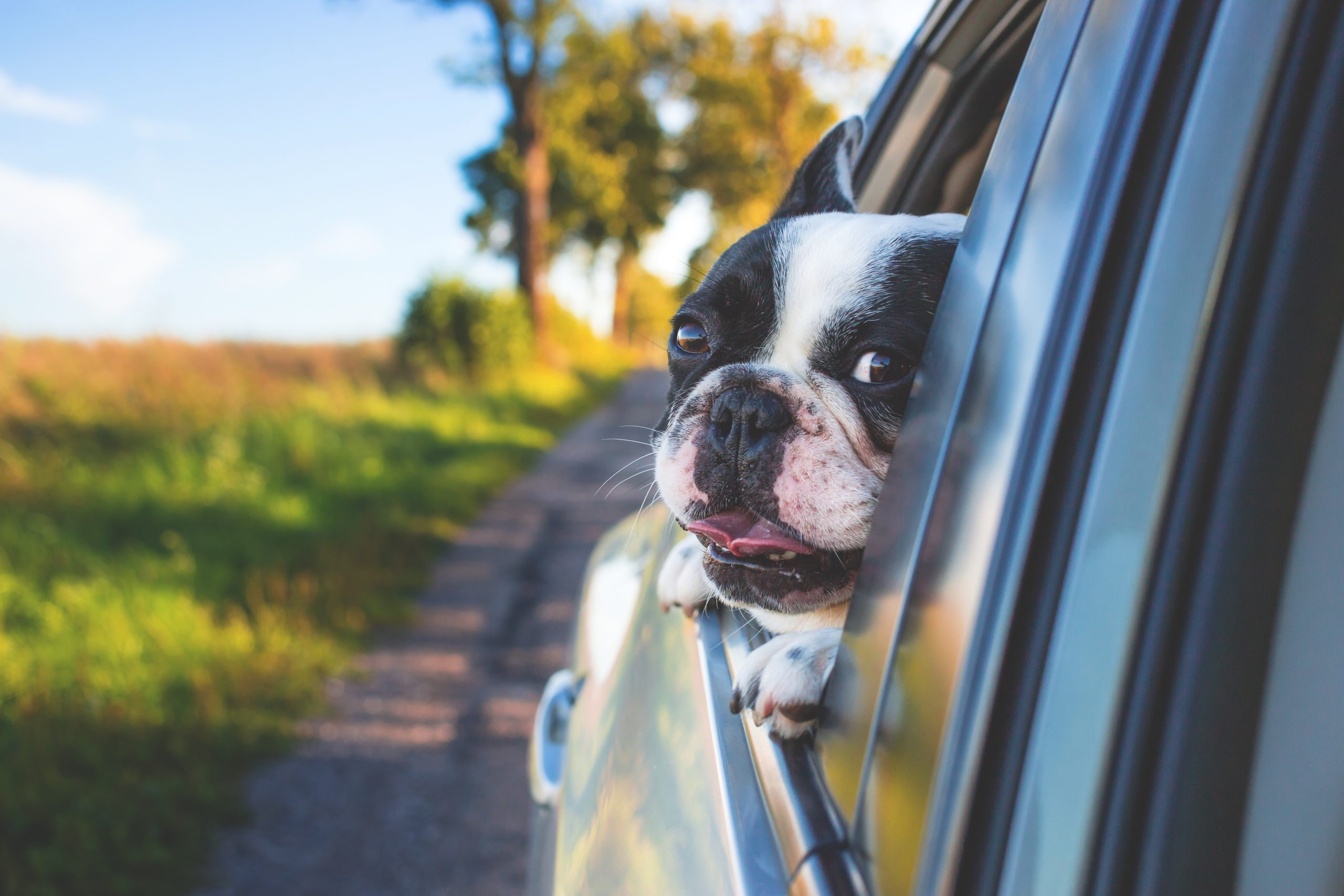Lifestyle
Build Your Dog’s Confidence with Car Travel: Tips and Tricks
If you’re a dog owner, you know that car travel can be a bit of a challenge for some pups. Some dogs find being in a moving car stressful and can show this in a number of ways, including barking, whining, heavy panting, vomiting, or even refusing to get into the car in the first place. The good news is that you can help your furry friend overcome this fear and build their confidence in car travel. In this blog, we’ll provide you with some tips and tricks to help your dog feel more comfortable and secure during car rides. From creating a familiar and comfortable environment to gradually introducing the inside of the car, we’ll take you through each step to help your dog associate car travel with positive experiences. With a bit of patience and consistency, you can turn car travel into an enjoyable experience for both you and your furry friend.

In this blog, you will learn how to help your dog feel more confident during car travel. Many dogs experience stress and exhibit behaviors such as barking, whining, panting, vomiting, or refusing to get into the car. To address this, it’s important to create a positive association with the car and ensure your dog is secured to prevent any potential risks.
The first step is to create a comfortable and familiar environment by placing your dog’s bed and blankets inside the car. This will help your dog feel more secure and reduce the likelihood of losing balance while the car is moving. If your dog is crate trained, a secured crate can also provide a safe space in the car.
Next, get your dog used to the car by walking them around the vehicle with the engine off and doors shut. Reward them with treats, toys, or praise whenever they calmly approach the car, sniff it, or investigate it. Continue these short sessions until your dog is comfortable walking near the car.
Once your dog is relaxed around the outside of the car, you can introduce them to the inside. Start by placing some of their blankets inside and reward them for moving towards the open door. Gradually move the treat further into the car until your dog feels comfortable climbing inside. You can also sit in the car with your dog and offer a long-lasting treat to help build a positive association.
The next step is to close the door while your dog is inside the car. Start by closing it for a few seconds and gradually increase the time. If your dog becomes worried, repeat the step with the door partly closed and gradually work up to a fully closed door.
Once your dog is comfortable with the door closed, introduce the sound of the engine. Keep the car stationary, engine running, with your dog inside and offer a treat to help them relax. Gradually increase the length of time the engine runs and only continue if your dog remains calm.
When your dog is familiar with the sound of the engine, start with short drives and gradually increase the distance. Make sure the first few trips are to fun places to build a positive association. By following these steps, you can help your dog feel more confident and comfortable during car travel. To learn more about teaching your dog new skills, visit our website.
Lifestyle
10 Expert Tips for Renting a Car in the US: The Ultimate Guide
Renting a car can be a convenient and affordable option when traveling in the United States. However, with so many options to choose from and factors to consider, the process of renting a car can quickly become overwhelming. That’s why we’ve compiled our top 10 expert tips to help make the process easier and ensure that you have a stress-free rental experience. From signing up for a car rental rewards program to avoiding expensive insurance options, inspecting your car, and refueling, our tips will help you navigate the car rental process like a pro. Whether you’re a seasoned traveler or renting a car for the first time, read on to learn our expert advice on renting a car in the US.

Let me present to you our expert tips and advice on renting a car during your trip. Although car rental may seem like an easy process, choosing the right options can be overwhelming. GPS, insurance, and refueling are just a few of the many considerations to take into account when renting a car. Therefore, we have compiled the top 10 tips that you need to know when renting a car in the US.
Before we dive in, we’d like to introduce ourselves to those of you who are new to our channel. Trip Astute is a travel channel that focuses on sharing tips and tricks to make traveling easier, more affordable, and enjoyable. Our goal is to help you maximize your travel experience by providing expert travel advice, points and miles strategies, and innovative gear. If you find our content interesting, please consider subscribing to our channel.
Now, let’s get started with our top tips. Some of these may be obvious to savvy and experienced travelers, but we hope that there are a few tips in here that are still helpful to you.
Tip number one is to sign up for a car rental rewards program. Some credit cards or your workplace may offer access to a car rental rewards program. If this is the case, make sure to enroll in the loyalty program. One of the biggest perks is that some of these programs allow you to skip the check-in counter and go straight to your car. By using your reservation app or checking the lot board for your name, you can get on the road faster. If you have a premium travel credit card like the Chase Sapphire Reserve, you may have access to higher status levels with rental car companies. Check out our video on maximizing these benefits on the Chase Sapphire Reserve for more information.
Tip number two is to inspect your car. Although you may be eager to hit the road, we recommend doing a quick visual inspection of your car’s exterior. Check for any damage, especially big scratches or dents, and make sure they are recorded before you leave the rental car lot. You don’t want to be held liable for any damages to the car that were there before you rented it, especially if you don’t have primary insurance coverage through a credit card.
Which brings us to tip number three – know your insurance options. Many premium travel credit cards offer primary insurance coverage for rental cars. This allows you to decline the expensive and limited insurance coverage offered by the rental car company. We have created a video that explains how this works and covers different scenarios for coverage. It’s a bit complicated, but it’s worth understanding before your next car rental.
Tip number four – don’t use points to book your car rental. Although this tip is a bit controversial, we’ve heard that car insurance coverage from a credit card only applies if you pay for the rental car in full with your credit card. Therefore, we generally pay for car rentals out of pocket instead of using points. However, if you have any experience or first-hand knowledge with this situation, please let us know in the comments section.
Tip number five is to avoid underage rental fees. Rental car companies often charge extra if you’re under 25 and want to rent a car. While this charge is hard to avoid if you’re under 25, there are some potential ways to get around it. If you’re a AAA member, you can get the fee waived with Hertz. And if you’re a USAA member, you can do the same with Enterprise.
Tip number six is to avoid refueling options. Rental car companies often offer refueling options that seem convenient but are generally a bad deal. One option is to refill your car to the necessary level, but at three or four times the normal cost of fuel. Another option is to pay for a full tank refill, but the per-gallon rate is generally a lot higher than the local gas stations. We recommend avoiding these options and simply refilling the tank yourself before returning the car.
Tip number seven is to consider your pickup and drop-off locations. Rental car companies may charge additional fees if you pick up or drop off the car at a different location than where you rented it. Therefore, it’s important to consider your travel itinerary and choose the most convenient pickup and drop-off locations to avoid these fees.
Tip number eight is to be aware of toll roads and fees. Some rental car companies may offer electronic toll payment options, but they often come with high fees. If you plan on using toll roads during your trip, it’s best to bring your own toll transponder or pay for tolls out of pocket to avoid these additional fees.
Tip number nine is to use GPS or navigation apps. Most rental cars come with GPS or navigation systems, but they may also come with additional fees. To save money, you can use your own smartphone and a navigation app like Google Maps or Waze. Just make sure to bring a phone mount to secure your phone in the car.
Finally, tip number ten is to return the car on time. Rental car companies may charge extra fees if you return the car later than the agreed-upon time. To avoid these fees, make sure to plan your trip accordingly and allow enough time to return the car before the deadline.
Overall, renting a car during your trip can be a convenient and cost-effective way to explore your destination. However, it’s important to be aware of the potential pitfalls and fees associated with car rental. By following these tips and doing your research beforehand, you can save money and have a stress-free rental car experience.
Read More: Best 8 Smart Ways to Save Money on Travel
Lifestyle
Best 8 Smart Ways to Save Money on Travel

Smart Ways to Save Money on Travel
Traveling can be costly, but with some careful planning and wise choices, you can stretch your budget and save money on your trips. Here are some of the best strategies for saving money while traveling:
1. Hunt for deals and discounts: Take advantage of websites and online resources that offer deals on flights, hotels, and activities. Subscribe to newsletters and follow your preferred travel companies on social media to stay updated on promotions and discounts. Utilize tools like Google Flights to compare prices and find the best deals.
2. Travel during the off-season: Prices for flights, hotels, and activities tend to be higher during peak tourist seasons. Consider traveling during the off-season to save money and avoid crowds, while also enjoying a more authentic travel experience.
3. Explore alternative accommodations: Hotels can be expensive, particularly in popular tourist destinations. Look into alternative accommodations like vacation rentals, hostels, or camping options to save money on your lodging.
4. Seek out free or low-cost activities: Many destinations offer free or low-cost activities that can be enjoyable while also being budget-friendly. Research ahead of time to find out about local parks, beaches, walking tours, or markets that you can explore without breaking the bank.
5. Pack light: Checking in a bag on a flight can be costly, so try to pack everything you need in a carry-on. This way, you can save money on baggage fees and minimize the risk of lost luggage.
6. Avoid tourist traps: Popular tourist attractions are often expensive and crowded. Instead of visiting these costly spots, consider looking for local experiences and hidden gems that offer a more authentic and budget-friendly travel experience.
7. Eat like a local: Dining out can be a significant expense while traveling. Save money by eating like a local, such as purchasing ingredients from local markets or supermarkets to cook your own meals, or trying street food and local restaurants that are often cheaper than tourist-oriented establishments.
8. Use public transportation: Renting a car can be expensive, especially for international travel. Consider using public transportation as a cheaper and more convenient option.
By following these tips, you can save money on your travels and enjoy a budget-friendly vacation. With some careful planning and wise decision-making, you can have a fantastic trip without breaking the bank.
Read More: Top 5 Places for Solo Travelers: Where to Stay for an Unforgettable Journey
Lifestyle
Top 5 Places for Solo Travelers: Where to Stay for an Unforgettable Journey

As a solo traveler, it can be difficult to find the perfect place to stay. You need a location that is safe, comfortable, and sociable. Moreover, it should allow you to easily connect with other travelers and make new friends.
So, where should you stay when traveling solo? Here are a few great options to consider:
Hostels:
Hostels are a popular choice for solo travelers. They usually have a communal atmosphere with shared dorm rooms and common areas, making it easy to meet other travelers. Hostels are often inexpensive, which is great if you are on a tight budget. However, keep in mind that you will be sharing a room with other travelers, so it may not be the ideal choice if you need privacy.
Airbnb:
Airbnb is a fantastic option for solo travelers because it enables you to stay in someone’s home or apartment. This can offer a more homey and comfortable experience than a traditional hotel, and it also allows you to experience the local culture. However, make sure to do your research and read reviews before booking an Airbnb, as not all hosts provide the same level of service.
Boutique hotels:
For those looking for luxury and privacy, a boutique hotel could be a great choice. These independent hotels tend to be smaller, providing a more personalized and intimate atmosphere that is ideal for solo travelers. Many boutique hotels also offer social events or activities for guests, which can be a perfect way to connect with other travelers.
Monasteries:
For a peaceful and unique stay, consider booking a stay in a monastery or convent. These accommodations are usually very affordable and offer a quiet, meditative environment. Some monasteries also provide opportunities for volunteering or spiritual retreats.
Camping:
If you love nature, then camping could be an ideal option for solo travel. Many campsites have communal areas, where you can meet other travelers. Additionally, camping is generally low-cost, making it a great choice for those on a tight budget. However, make sure to follow Leave No Trace principles and respect the environment.
Regardless of where you choose to stay, always be cautious and aware of your surroundings when traveling alone. Do your research beforehand and let someone know where you’ll be staying. With some planning and preparation, traveling solo can be an amazing and fulfilling experience.
Read More: Make Traveling Easier with the Help of These Handy Apps
-

 Fashion7 years ago
Fashion7 years agoThese ’90s fashion trends are making a comeback in 2017
-

 Finance11 months ago
Finance11 months ago5 Smart Investment Ideas for Beginners in 2023: A Comprehensive Guide
-

 Entertainment7 years ago
Entertainment7 years agoThe final 6 ‘Game of Thrones’ episodes might feel like a full season
-

 Fashion7 years ago
Fashion7 years agoAccording to Dior Couture, this taboo fashion accessory is back
-

 Entertainment7 years ago
Entertainment7 years agoDisney’s live-action Aladdin finally finds its stars
-

 Entertainment7 years ago
Entertainment7 years agoThe old and New Edition cast comes together to perform
-

 Sports7 years ago
Sports7 years agoPhillies’ Aaron Altherr makes mind-boggling barehanded play
-

 Business7 years ago
Business7 years agoUber and Lyft are finally available in all of New York State



